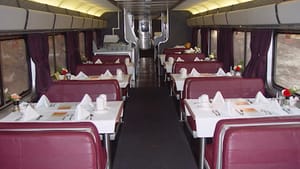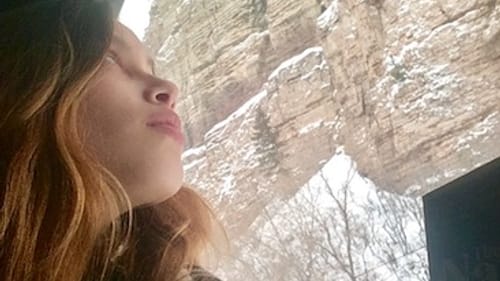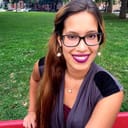Stay in the Loop
BSR publishes on a weekly schedule, with an email newsletter every Wednesday and Thursday morning. There’s no paywall, and subscribing is always free.
Brief encounters
Erlina Ortiz rides the Zephyr on an Amtrak Writer's Residency

Several months ago, when I learned I had been selected for the Amtrak Writer’s Residency, I arbitrarily picked January 23, 2017, for my departure. I welcome anything that can get me away from the East Coast and the dread of winter for a few days.
Riding the rails
The California Zephyr line was advertised as Amtrak’s most beautiful ride. It takes about three days on the train, with the final stop in San Francisco, for a total of ten days. I did not anticipate that I would begin my travels in the first full week of 45’s administration.
A few days before my departure, I became overwhelmed with anxiety. I read some blog posts from past Amtrak fellows and learned that breakfast, lunch, and dinner are full sit-down meals. If you are traveling alone, they seat you with another party. I’ve always been the type of person to strike up a conversation with just about anyone, so that wasn’t my worry. To be honest, my (slightly irrational) worry was: I am going to have to eat lunch with a bunch of racists.
Growing up in a Dominican immigrant household in a mostly black and Latino neighborhood, I wasn’t completely blind to the discrimination facing our brothers and sisters of color. However, I was the lightest of everyone in my family, and if not for my slightly "ethnic" features, most people could easily label me Caucasian. I wanted so badly to be chocolate like my brothers, with their long, dark eyelashes, or to have curly black hair like my mother. I was completely ignorant of the privilege afforded me by my white skin and straight hair; I just wanted to fit in, like everyone else.
{photo_2}
I have a generally positive outlook, but after the election, seeing the hate so many Americans have for people like me left me suspicious and wary. I was painfully aware that I wouldn’t be able to scan the dining room for red hats before deciding who was friend and who was foe. I didn’t know what I would do if I was seated at a table with a bunch of Trump supporters. Before my first meal in the dining car I remember thinking something that would have been alien to me before 2016: Thank God I look white. But it turned out I had another secret weapon: theater!
Kindred spirits
On day one, somewhere near Ohio, I was seated with two women returning from the Women’s March on Washington. I immediately placed them into the "ally" category and thought, Okay, maybe this won’t be so bad! One of the women, Claudia, was a gentle soul and an artist at heart. I felt safe and told her I am a playwright whose work often deals with social justice and women’s rights. She shared with me that she loves theater and once wanted to be an actress. Karla had an even more interesting story: She is a pastor. She said she never tells people that right away because they assume she is a “right-wing religious nutjob.”
She’s right. I felt bad because if she'd told me that when I first sat down, I know exactly the assumptions I would have made about her. I was aware of how problematic (though not uncalled for) my fear was. But I made a vow: to live my truth and not be afraid to stir the pot. I vowed to be real.
Keeping it real
This philosophy served me well. Almost every conversation started with people asking about my travels and me responding, “Actually, I’m an Amtrak Resident Writer.”

This was always followed by, “And what do you write about?”
I’d reply, “My plays tend to deal with issues of social justice, such as gentrification, rape culture, and domestic violence. My characters often represent Latino immigrant families, as I come from an immigrant family myself.” It was a straightforward way not just to break the ice but smash it. Every time, my heart raced and I thought, “Okay! Let’s see what happens.” Every time, I was pleasantly surprised.
Near Utah, I met Karen, and later, Dave. I don’t know how Karen, who told me she was fleeing domestic violence, voted. All I know is she seemed very brave. I’ll never forget when she said, “This trip is the first time in many years I have felt safe.” I knew if I hadn’t just told her about my play Morir Sonyando, which deals with domestic violence, she might never have uttered that sentence.
I don’t know if Dave was secretly racist. I know that after talking to him about my play She Wore Those Shoes, he seemed to feel comfortable sharing that he was suffering from PTSD and had done two tours in Afghanistan. This type of surprising openness and honesty happened over and over, and I’m convinced the gods of art and theater helped me along.
Art will save us
Statistically speaking, it's likely that I sat with some Trump supporters. As time went on, though, I decided to not approach every meal with that anxiety at the forefront. I simply allowed myself to be who I am and share what I believe in. These times are scary because an evil we thought was submerged has suddenly resurfaced, but we cannot be afraid to fight back. Even more important, I am convinced that the only way forward is through art, by sharing our stories with honesty and relaying the vast diversity of our experiences. I am terrified of what the years ahead might bring, but I know we are going to create some bangin’ art in the meantime.
If you’d like to learn more about my trip, follow my blog here.
Sign up for our newsletter
All of the week's new articles, all in one place. Sign up for the free weekly BSR newsletters, and don't miss a conversation.
 Erlina Ortiz
Erlina Ortiz